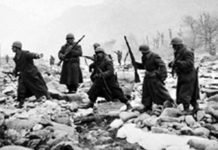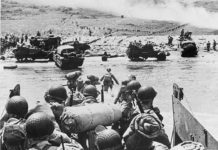Generally the Cold War is considered to have begun in the late 1940s to 1990, and left the US as the only remaining superpower.
The phrase Cold War was used to describe the intense post – war rivalry between the Soviet Union and the US that became noticeable in the late 1940s.
From Allies to Rivals – Early Years of Conflict
Due to the German invasion of the Soviet Union and the Japanese attack on Pearl Harbor the Americans and the Soviets had become unexpected allies even if they started fighting later than Britain or the Axis powers. The US went on to fund the Allied war efforts whilst the Soviets did most of the fighting and suffered the highest number of deaths.
There were of course plenty of reasons why the wartime alliance between the Post – War superpowers was a pragmatic arrangement that was highly unlikely to survive too long after the defeat of Germany and Japan. After all before the Second World War the Americans and the Soviets had endured a strained relationship with each other.
The future of war torn Europe was a major cause of the Cold War despite the agreements made by the Big Four (Britain and France as well as the Soviet Union and the US) at the Potsdam and Yalta Conferences in 1945. The Americans had hoped that the Soviets would allow the states become capitalist liberal democracies instead of mere satellites of the Soviet Union.
Stalin was determined that the countries of Central and Eastern Europe should all become People’s democracies to spread Communism and improve the security of the Soviet Union. The Soviets argued that the spread of Communism had been agreed to yet it disturbed the Americans leaving the Truman administration unsure of Stalin’s intentions towards Western Europe. The Berlin Blockade and subsequent airlift led to the forming of NATO and its counterpart the Warsaw Pact.
The Korean War, a Missile Crisis, Détente and Soviet Collapse
American fears about the spread of Soviet inspired Communism were increased by the Chinese Revolution alongside the establishment of Marxist regimes in North Korea and later North Vietnam. In 1950 the Cold War came very close to becoming the Third World War when North Korea invaded South Korea with the approval of the Kremlin. The US was able to send assistance and the United Nations forces drove the North Koreans back to the Chinese border. When the Chinese attacked the UN it led Truman to consider using nuclear weapons.
After the end of the Korean War the superpowers increased the scale of the nuclear arms race and based missiles in allied countries. Although they tried to normalize their relationship the Cold War still continued. Tensions rose again as a result of the Cuban Revolution as the regime of Fidel Castro looked to the Soviets for protection from the threat of US backed invasion.
The Cuban Missile Crisis was the closest that the superpowers came to fighting a nuclear war. The Americans detected Soviet missile bases on Cuba and war seemed likely after a U2 spy plane was shot down. Eventually the missiles were removed on the understanding that the US would not invade Cuba.
After the Cuban Missile Crisis there were concerted efforts to improve superpower relations in a process dubbed detente. As a result the growth of the nuclear arms race was slowed down by the SALT I treaty of 1972. Detente was brought to a halt by the Soviet invasion of Afghanistan seven years later. When Ronald Reagan became US President the Cold War intensified.
However the Cold War unexpectedly ended as a consequence of the collapse of the Soviet Union. Under Gorbachev attempts to reform the economy ultimately failed yet led to arms cuts and the withdrawal of Soviet forces from Afghanistan. When the Communist regimes of the Warsaw Pact collapsed Moscow did nothing to restore them.
Sources:
- Evans G & Newnham J, (1998) the Penguin Dictionary of International Relations, Penguin, London
- Hobsbawm, E (1994) Age of Extremes, the Short Twentieth Century 1914-1991, Michael Joseph, London
- Klein N (2007) The Shock Doctrine, Penguin, London
- Lenman B, (2004) Chambers Dictionary of World History, Edinburgh
- Palmowski J, (2008) Oxford Dictionary of Contemporary World History, Oxford
- Watson J, (1997) Success in World History since 1945, John Murray, London
- Woodruff, W (2005) A Concise history of the Modern World, Abacus, London








